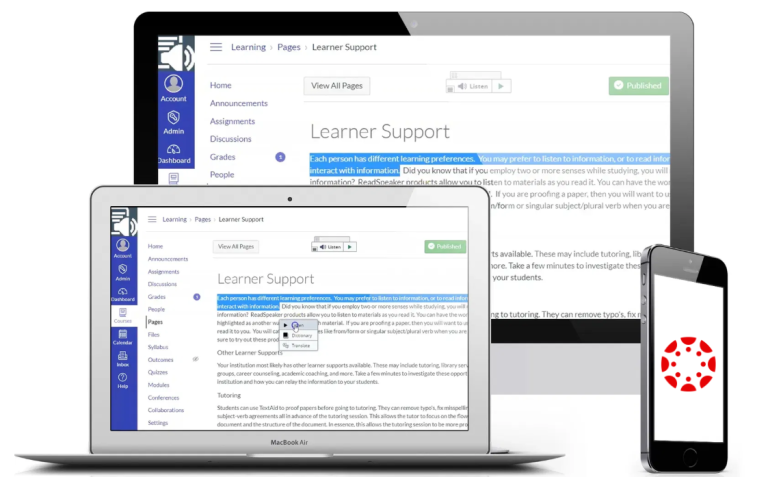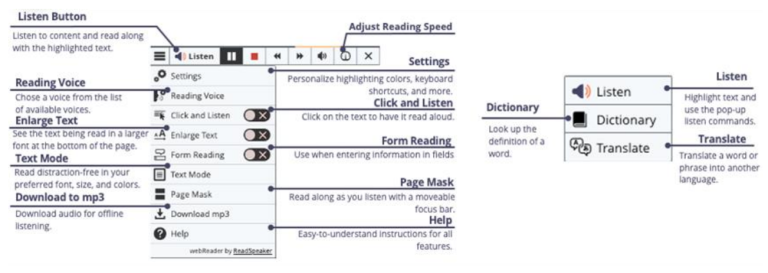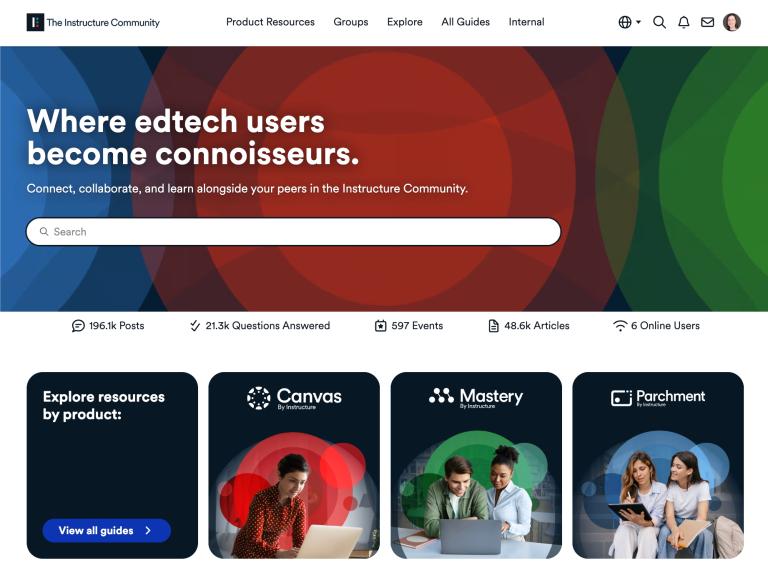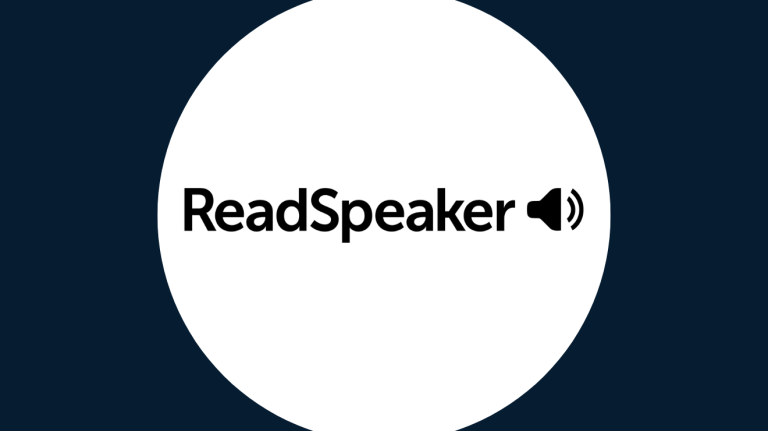When educational institutions integrate powerful assistive technologies like ReadSpeaker text-to-speech into their Canvas LMS implementation, the initial focus often centers on providing audio support for learners with disabilities. This perspective is not only vital but legally mandated for ensuring compliance with accessibility standards and fostering an inclusive learning environment for all. However, what if we were to broaden our understanding and thoughtfully shift our perspective even further? Consider the transformative potential when all students, not only those with formal accommodations or diagnosed learning differences, are empowered to listen to their course content. The myriad benefits of such an approach extend far beyond basic accessibility support, creating a more flexible, engaging, and effective learning experience for everyone.
Unlocking Comprehension for Diverse Learners
The reality of modern education is that even students without formal reading disabilities or diagnosed learning challenges frequently encounter significant hurdles when faced with dense, complex, or jargon-heavy academic texts. This is particularly true for non-native English speakers who are simultaneously navigating new language structures, nuanced idiomatic expressions, and complex subject matter. Similarly, students encountering highly technical vocabulary for the first time in specialized fields like engineering, medicine, computer science, or advanced humanities can struggle to grasp new terms and concepts solely through silent reading. In other cases, students who have grown up in the era of podcast and video content are simply comfortable with an audio experience. No matter the circumstances, the act of hearing the words spoken aloud while reading can be an incredibly powerful and often overlooked tool for improved comprehension. Audio support provides a multifaceted approach to learning, assisting with:
- Pacing: Students can effortlessly follow the natural rhythm and cadence of spoken language, which can be far more intuitive and less mentally taxing than silently decoding complex text word by word. This allows for a smoother flow of information processing. (PubMed study on pacing and reading fluency)
- Pronunciation: Correct and consistent pronunciation of new, unfamiliar, or highly complex terms is absolutely crucial not only for accurate understanding but also for building academic confidence and effective communication. (PubMed article on pronunciation and language acquisition)
- Word Recognition: The act of hearing words while also seeing them can significantly reinforce visual word recognition, particularly for challenging vocabulary or terms that students might otherwise skip or misread. This dual sensory input strengthens memory pathways. (PubMed article on multisensory word recognition)
- Comprehension: The auditory channel acts as a powerful and complementary pathway to understanding, especially when material is difficult to grasp conceptually. It can help bridge gaps in understanding that visual processing alone might leave open, providing a second chance at internalizing information. (PubMed research on auditory support and comprehension)
- Cognitive Load Reduction: By removing the decoding task from the visual system, students can free up cognitive resources to focus more intently on the meaning and implications of the content, rather than struggling with the mechanics of reading itself. (PubMed study on cognitive load and reading)

Providing Audio Support with Unparalleled Ease
ReadSpeaker's straightforward "Listen" button makes it instantly accessible and immediately understandable for Canvas users, effectively removing significant barriers and encouraging voluntary adoption across the student body. The seamless integration means that students don't need special software, plugins, or extensive training; the functionality is simply there when and where they need it.
As Eric Turner, an educational technologist from Mt. San Antonio College, attests, "the success of any educational tool hinges on its user-friendliness. If it’s not easy and intuitive, students won’t find it and use it. I think that is why you have seen such a large number of students starting to use it as they are finding it on their own. I mean it says ‘Listen’. How much easier can you get?”
Turner's emphasis on ease and intuitive access underscores a universal and critical truth in educational technology adoption: for any tool to truly benefit all learners, it must be frictionless. Students in today's demanding academic environment are already managing demanding schedules, complex course loads, all while juggling a multitude of digital tools and platforms. If an educational tool requires significant effort to locate, a steep learning curve to master, or cumbersome steps to operate, its adoption will inevitably be limited, reducing its potential impact. You can hear more of Eric Turner's insights and learn about the impact of ReadSpeaker by watching the full interview here.

Empowering Personalized Learning Journeys for Every Student
Beyond its ease of use, ReadSpeaker offers a robust and comprehensive suite of personalization options that empower students to tailor their learning experience according to their individual preferences and unique needs. This level of control over their learning environment is a hallmark of modern, student-centered pedagogy. Students can customize various aspects of their audio experience, including:
- Voice Selection: The ability to choose a voice that is most comfortable, engaging, or simply preferred allows for a more pleasant and less distracting listening experience. Options often include different genders, accents, and tones, catering to diverse populations.
- Highlight Colors: Students can select their preferred colors to visually follow along with the text as it is simultaneously read aloud. This synchronized highlighting significantly aids focus, reinforces the connection between the spoken and written word, and improves retention by engaging both visual and auditory processing channels.
- Reading Speed Adjustment: The power to precisely adjust the pace of the audio to perfectly match their comprehension level is invaluable. Whether they need to slow it down to absorb more complex material or speed it up for quick review of familiar content, this flexibility optimizes their engagement and understanding.
A Holistic Approach to Learning Enhancement
While accessibility understandably remains an essential focus for ReadSpeaker, the broader, far-reaching benefits of audio-enabled support for all learners are compelling and, sometimes underappreciated. When high-quality audio becomes a seamless, readily available option within Canvas, every single student is given the invaluable opportunity to choose how best to engage with their academic content. This flexibility is not merely a convenience; it actively fosters and supports a multitude of critical learning outcomes:
- Improved Retention: Active, multimodal engagement through simultaneous listening and reading can lead to better recall and long-term memory of learned material allowing listeners to move information from short-term to long-term memory more effectively. (APA research on multimodal learning and retention)
- Increased Focus and Concentration: For many students, listening to text can be a powerful strategy to maintain concentration and minimize distractions, especially when students may be grappling with complex content that might otherwise lead to mind-wandering. (PubMed study on auditory learning and attention)
- Greater Agency and Self-Efficacy: When students feel they have control over how they learn, they become more invested, motivated, and confident in their abilities. This heightened sense of agency translates into increased self-efficacy and a more proactive approach to their academic journey. (CAST resource on audio-supported reading)
- Reduced Eye Strain and Fatigue: Prolonged screen time and intense reading can lead to significant eye strain and mental fatigue. Audio support provides a welcome respite, allowing students to continue learning when eye fatigue sets in. (MDPI study on visual fatigue and screen reading)
- Preparation for Future Success: In many professional fields, the ability to process information through listening is a valuable skill. Integrating text-to-speech helps students develop and refine these crucial auditory processing skills. (PubMed research on auditory processing and professional learning)
The ReadSpeaker integration with Canvas LMS is part of a comprehensive, forward-thinking approach to the enhancement of learning and empowerment of learners. Incorporating audio options helps to transform the learning experience from a rigid, one-size-fits-all model into a dynamic, highly personalized, and adaptable journey where every student can forge their optimal path to understanding, mastery, and academic success. This is not just about meeting minimum accessibility requirements; it is about elevating the learning experience for the entire student population.
Ready to explore how ReadSpeaker can revolutionize the learning experience for all students within your Canvas environment? Register for our upcoming webinar to see firsthand how this intuitive, powerful tool can elevate engagement, deepen comprehension, and enhance academic achievement across your entire institution, fostering an environment where every learner can thrive.
Related Content
 inst-3step.jpg
inst-3step.jpgBlogs
 community-homepage.jpg
community-homepage.jpgBlogs
 kim-classroom.jpg
kim-classroom.jpgBlogs
